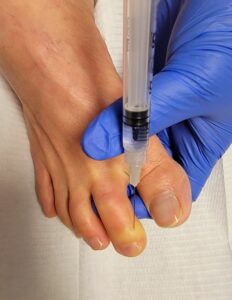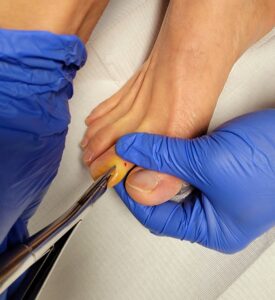This medical condition in the feet occurs so frequently. I want to write this blog with the purpose of explaining the cause of the problem, offering a conservative option, and easing people’s anxiety about the procedure should the nail’s corner be removed permanently. Ingrown toenails do hurt and become chronic in nature if left untreated. At times, it causes severe pain, inflammation, and infection.
What is an ingrown toenail?
An ingrown toenail is a toenail that is too wide and curvy at the corner(s). It digs into the flesh of the skin; thus, it causes pain and swelling for it acts like a little dagger at the corner. Unless the cause of the problem is addressed, the constant pain is present, and at times, the toe can get infected.
Conservative treatment for a mild flare-up
Most people with an ingrown toenail try to remove the offending corner themselves. If you do, angle the nail clipper at an oblique angle and carefully trim the offending border. Soak the affected foot for 15 minutes in Epsom salt and warm water to reduce the inflammation. Dress the toe with antibiotic ointment daily. Repeat the process until the toe heals. Keep in mind that this conservative effort is only a temporary fix. As the nail grows longer, the condition returns. If the pain and redness persist, seek consultation with your local podiatrist. You may require oral antibiotics and/or procedures to remove the cause of the problem, which is the ingrown toenail corner(s).
How is an ingrown toenail removed?
First, local anesthetics is given to the toe.

The toe is prepped, and the corner is removed using a special instrument to detach the nail at the corner.
The offending corner is clipped and taken back to the nail root.

The entire corner is removed.

Acid is applied to the exposed nail root to prevent the regrowth of the corner. Thus, this step offers a permanent resolution to your condition.

A bulky dressing is applied to control the bleeding. And soaking instructions at home are given to allow the toe to heal properly.

This office procedure is a quick and permanent resolution for the patient who suffers from this chronic and painful condition. Overall, this procedure involves little pain postoperatively. As a patient, you can return to a functional level as tolerated. No downtime is necessary. Soaking of the foot is required to allow the toe to heal properly. It takes up to 2-3 weeks post-procedure to see complete healing.
Dr. Dang H. Vu, DPM is a Baltimore Podiatrist with more than 18 years of experience. He completed his residency at Sinai Hospital of Baltimore, where he furthered his surgical expertise. He now holds privileges at Northwest Hospital. He offers services from three Baltimore Locations in Reisterstown, Towson, and Hampden. You can find directions and request an appointment on his website FamilyPodiatryofMD.com
